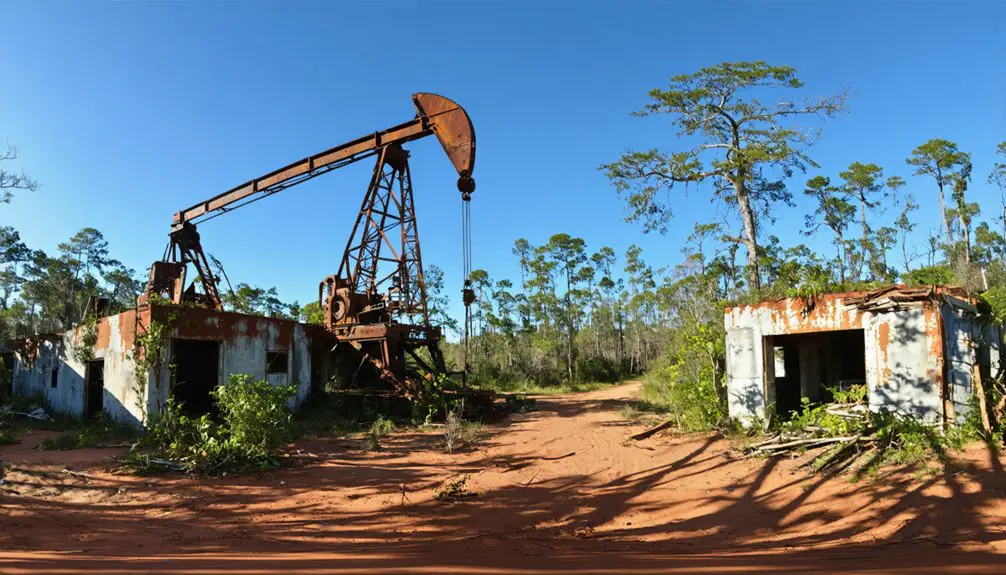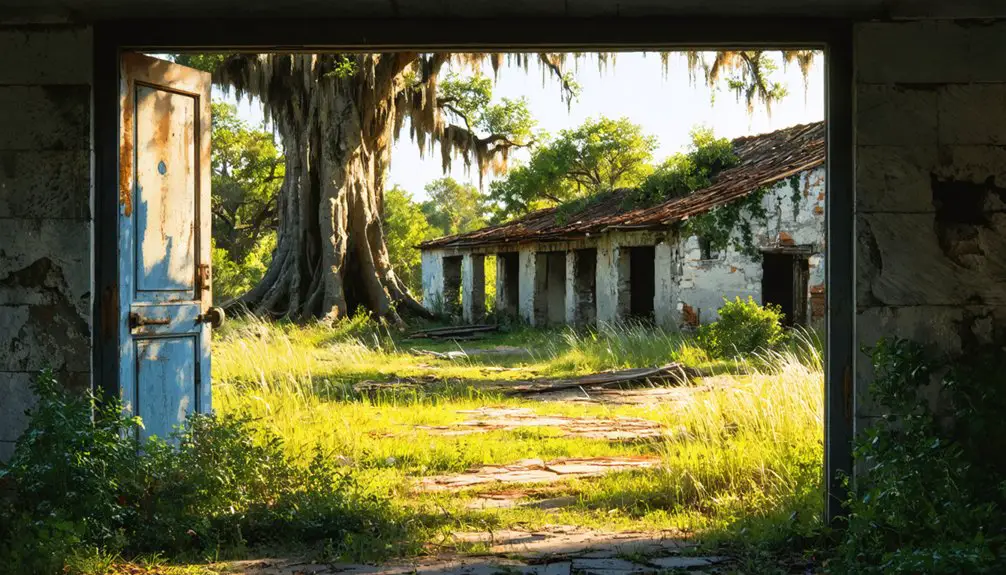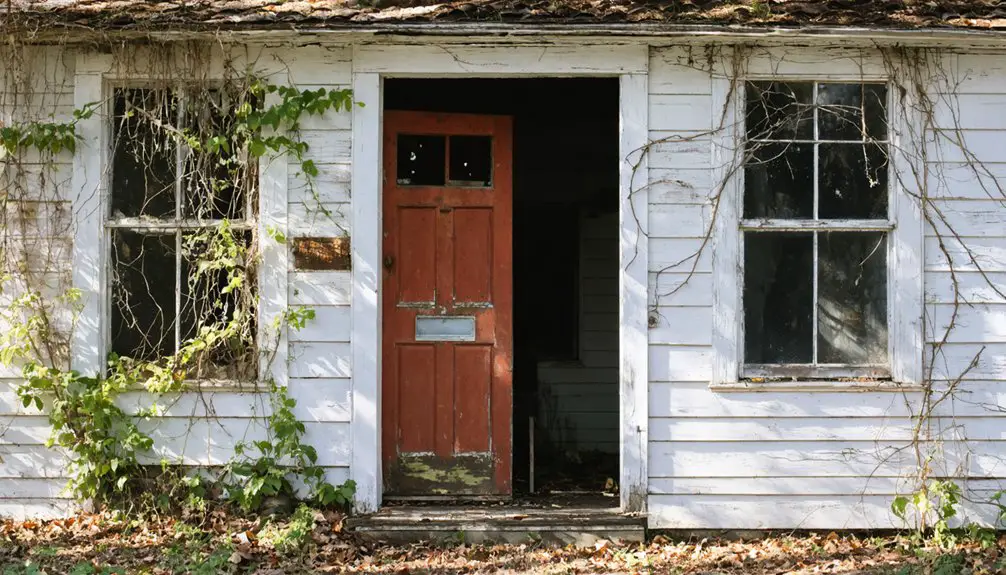You’ll find Cosme’s story began in the early 1900s as a thriving railway settlement in Florida. The Tampa Gulf Coast Railway established it as a scheduled stop by 1910, while turpentine storage tanks and a citrus packing house drove the local economy. Hungarian immigrants and pioneer families built a diverse community around the train depot, but economic decline and environmental challenges led to its abandonment by 1960. The forgotten town’s deeper history reveals surprising connections to Florida’s industrial past.
Key Takeaways
- Cosme was a thriving early 1900s Florida settlement centered around turpentine production and citrus packing, with railway access via Tampa Gulf Coast Railway.
- The community featured essential infrastructure including turpentine storage tanks, a citrus packing house, and a train depot serving diverse residents.
- Economic activities primarily depended on timber, turpentine, and citrus industries, employing thousands near Lafayette Creek until market shifts occurred.
- By 1960, railway tracks were removed and major employers closed operations, leading to significant population decline and eventual ghost town status.
- Environmental challenges, declining birth rates, and loss of community services contributed to Cosme’s abandonment after its peak industrial period.
Early Settlement and Pioneers
During the first decade of the 1900s, Cosme emerged as a bustling Florida settlement centered around its essential railroad depot. As pioneer families arrived to establish homesteads, they quickly developed the early infrastructure needed to support their growing community.
Early 1900s Cosme flourished around its railroad depot as pioneering families built the foundation for their new Florida community.
You’ll find they built strategic facilities like turpentine storage tanks near the depot and a citrus packing house to process local harvests. The Citrus Exchange employed many Hungarian residents who became vital contributors to the local economy.
The settlement followed patterns typical of Florida towns during this era, with residents focusing on converting the area’s natural resources into profitable commodities. Much like Viking Town in St. Lucie County, early settlers relied heavily on agriculture to sustain their community. While specific founding families aren’t documented for Cosme, the community grew like many others nearby, such as Sparkman, which was established around 1905.
These early settlers created a close-knit community sustained by agriculture and resource-based industries.
Transportation and Railway Connection
As the Atlantic Coast Line Railroad laid tracks through Cosme in 1883, the settlement gained its essential connection to Florida’s growing rail network.
By 1910, the Tampa Gulf Coast Railway division of Seaboard had purchased this segment, establishing Cosme as a scheduled stop.
The railway infrastructure proved crucial to the local economy, serving turpentine storage tanks and citrus packing facilities near the depot.
The Citrus Exchange, which employed many Hungarian residents, relied heavily on the rail line for transporting goods and workers.
Natural erosion and flooding posed significant challenges, requiring the tracks to be built on elevated embankments above the surrounding terrain.
You’ll find no physical traces of Cosme’s railway heritage today – the tracks were removed in 1960, accelerating the area’s decline into ghost town status.
Like many small Florida communities, Cosme’s fate was sealed when it lost its critical transportation lifeline.
This pattern of decline mirrored other Florida railways, as passenger service declined dramatically across the state by the mid-20th century.
The Turpentine Industry Era
While the turpentine industry had flourished in the Carolinas, it expanded southward into Florida by the late 1800s, establishing a significant presence in Cosme.
You’d find workers creating “catfaces” on pine trees, collecting resin through metal gutters and Herty cups. These operations led to prevalent turpentine camps throughout the region. The turpentine production process was intensive – 50 gallons of pine sap yielded about 325 pounds of pitch and tar, plus 10 gallons of liquid turpentine.
Labor conditions in Cosme’s naval stores camps were harsh. African-American workers and leased convicts faced brutal treatment, earning only company scrip redeemable at company stores. This system trapped workers in a cycle of debt and exploitation. Many workers were arrested for minor vagrancy offenses to maintain the labor force.
Workers endured brutal conditions in Cosme’s turpentine camps, trapped by a predatory system of company scrip and exploitation.
The industry’s presence transformed Cosme’s economy until its decline in the early 20th century, when petroleum-based alternatives began replacing turpentine products.
Daily Life in Early Cosme
In the early 1900s, life in Cosme centered around the Tampa Gulf Coast Railway and its essential facilities.
You’d find a diverse community where Hungarian immigrants lived in tents west of town, while pioneering families like the Mobleys and Simms occupied wooden frame houses near the tracks.
Daily routines revolved around labor dynamics at the turpentine storage tanks and The Citrus Exchange’s packing house.
You’d witness workers processing pine resin and sorting citrus fruits while freight trains carried goods to distant markets.
Community gatherings often took place near the train depot, where Reverend Walker led religious services.
The railway didn’t just transport products – it brought news, mail, and connected you to neighboring towns for essential services like schooling that weren’t available in Cosme.
Like many Florida towns of that era, Cosme’s economy was vulnerable to the devastating freezes that would later destroy countless citrus groves.
Workers collected sap using special Herty cups attached to pine trees, similar to the methods used in the Etna turpentine camp.
Economic Activities and Trade
The economic pulse of Cosme beat strongest through its three main industries: timber, turpentine, and citrus. You’d have found thousands employed in the bustling sawmills, where timber trade thrived alongside extensive logging operations on roads and rail trams near Lafayette Creek.
The Atlantic Coast Line Railroad, reaching Cosme in 1883, became the town’s lifeline for commerce. At the depot, you’d have spotted turpentine storage tanks and a citrus packing house where the Citrus Exchange coordinated exports. Population surged to 587 by 1930 due to mill jobs and operations.
Hungarian immigrants joined the workforce, packing fruit for distant markets. The Tampa Gulf Coast Railway, taking control in 1910, kept goods flowing until 1960. With no replanting of timber resources, the town’s economic foundation gradually eroded.
Company stores, often paying workers in scrip, controlled local commerce while the forest industries steadily depleted natural resources.
Notable Figures and Developers
Among Cosme’s most influential pioneers, William L. Mobley helped establish the town’s early foundation.
The community’s development gained momentum when A.J. Simms spearheaded the Walker Heights subdivision project, named after influential leader Reverend Charles Walker, who made significant community contributions through his religious and civic leadership.
The Mogyorosys family emerged as prominent Hungarian pioneers, representing a larger Hungarian workforce that became essential to Cosme’s citrus industry.
These influential leaders shaped the town’s character through various land developments and community initiatives.
Frank Peterson also stands out among the early residents who helped shape Cosme’s identity.
Together, these figures established important transportation links through the Tampa Gulf Coast Railway, which served as a scheduled stop until 1960, fostering economic growth and connecting Cosme to neighboring communities.
Natural Resources and Land Use

Longleaf pine forests dominated Cosme’s early landscape, providing the foundation for its primary industries. The natural resource management practices of the time focused heavily on turpentine extraction, with workers tapping live pines for their valuable resin.
You’ll find evidence of significant land use changes as logging operations cleared vast tracts for timber harvesting.
- The Tampa Gulf Coast Railway enabled efficient transport of forest products from Cosme’s storage tanks
- Local immigrant workers, including Hungarians, sustained the thriving turpentine camps
- After forest depletion, citrus cultivation emerged as an alternative economic activity
As the pine stands diminished, Cosme’s economy struggled. The Citrus Exchange and packing house briefly sustained the town, but agricultural ventures couldn’t match the prosperity of the turpentine era.
Today, you’ll see younger pine forests and wetlands reclaiming the abandoned settlement.
Factors Leading to Abandonment
While several factors contributed to Cosme’s abandonment, economic decline proved the most devastating. The community’s economic vulnerabilities stemmed from its reliance on a limited range of industries, leaving it susceptible to market shifts and resource depletion.
When major employers closed their operations, you’d have seen a significant population outflow as workers sought opportunities elsewhere.
Environmental challenges further accelerated the town’s decline. The harsh Florida terrain made infrastructure development difficult, while diseases common to swampy areas likely impacted population health and settlement sustainability.
As younger residents moved away to urban areas with better prospects, Cosme’s social fabric began to unravel. The loss of essential community services and declining birth rates sealed the town’s fate, transforming it from a hopeful settlement into another Florida ghost town.
Historical Significance and Legacy

You’ll find that Cosme’s significance stems from its role as a crucial transportation hub, where the Tampa Gulf Coast Railway and Atlantic Coast Line Railroad intersected to facilitate regional trade.
The town’s position in Florida’s turpentine industry, supported by its storage facilities and immigrant labor force, exemplifies the state’s early industrial development.
The settlement patterns established by pioneer families like the Mobleys and Mogyorosys demonstrate how small agricultural communities helped shape Florida’s rural landscape in the early 1900s.
Early Transportation Hub Legacy
As Florida’s coastal communities expanded in the late 19th century, Cosme emerged as an essential transportation nexus that shaped the region’s development.
You’ll find that transportation innovations like the shift from sail to steam vessels revolutionized maritime trade, connecting Southwest Florida to global markets through Cosme’s strategic waterways.
- Key West-bound steamers regularly stopped at Cosme, delivering mail and supplies to frontier settlements.
- Phosphate shipments from the Peace River region flowed through Cosme’s transport network.
- Local farmers relied on Cosme to ship citrus and vegetables to distant markets.
You can trace Cosme’s influence on regional growth through its role in connecting isolated communities, particularly Sanibel and Captiva Islands, to the mainland.
The hub’s maritime infrastructure laid the foundation for modern Southwest Florida’s transportation systems.
Florida Turpentine Industry Impact
During Florida’s industrial expansion from 1905 to 1923, the turpentine industry transformed Cosme into a bustling naval stores hub, surpassing Georgia in production output.
You’d find massive turpentine production operations throughout the region, with stills processing between 18 to 36 million gallons annually during the peak years of 1910-1925.
The industry’s dark underbelly revealed itself through labor dynamics that relied heavily on convict leasing from Florida’s prison system.
You’ll note that these remote turpentine camps, scattered throughout the pine forests, faced scrutiny for their harsh conditions.
After a 1922 inmate murder, public outrage led to legislative reform that banned convict labor in turpentine operations.
While the industry brought significant wealth to Cosme, it also left an indelible mark on both the social landscape and surrounding pine forests.
Pioneer Settlement Development Pattern
While the Atlantic Coast Line Railroad established tracks through the area in 1883, Cosme’s pioneer settlement didn’t take root until 1900-1910, when the Tampa Gulf Coast Railway designated it as a scheduled stop.
The settlement patterns followed typical Florida pioneer community development, with infrastructure and residents clustering around the depot.
Key features of Cosme’s development included:
- A mixed economy driven by turpentine storage and citrus packing operations
- A diverse population including local pioneers like William L. Mobley and Hungarian immigrants
- Transportation-centric growth that positioned the depot as the community’s heart
The pioneer community thrived through its railway connection, supporting both agricultural and industrial ventures.
When the tracks were removed in 1960, Cosme’s centralized community gradually disappeared, though its legacy lives on through local landmarks and family names.
Frequently Asked Questions
Were There Any Schools or Churches Established in Cosme?
Despite Rev. Charles Walker’s presence, you won’t find any documented school history or church significance in Cosme. The town’s 100% focus on industry left education and worship to informal, home-based gatherings.
What Happened to the Original Buildings and Structures After Abandonment?
You’ll find the buildings were lost to severe decay when the Great Depression drove residents away. Without historical preservation efforts, structures vanished through demolition, salvage, and nature’s reclamation of the site.
Did Any Descendants of Original Cosme Settlers Remain in Nearby Areas?
Through hardship and hope, through struggle and survival, you’ll find descendant stories lingering nearby – especially in Walker Heights, where A.J. Simms’ legacy lives on, though most Hungarian families left during the Depression.
Were There Any Significant Natural Disasters That Affected Cosme?
You won’t find records of major natural disasters that directly impacted Cosme. While Florida faced hurricanes and flood damage regionally, historical documents don’t show specific catastrophic events affecting this settlement.
What Was the Peak Population of Cosme During Its Most Prosperous Period?
Lost in time’s mysterious shadows, you’ll find no exact peak population records, but given historical significance and economic factors, it’s reasonable to estimate Cosme reached between 100-300 residents during its heyday.
References
- https://floridatrailblazer.com/category/ghost-towns/page/2/
- https://www.youtube.com/watch?v=bx7eU14uI24
- https://www.florida-backroads-travel.com/florida-ghost-towns.html
- https://en.wikipedia.org/wiki/Sisco
- https://www.ghosttowns.com/states/fl/cosme.html
- https://www.youtube.com/watch?v=TxBONhwNi1k
- https://cchistoricalsociety.com/lost-towns/
- https://www.croninbooks.com/post/higley-a-florida-ghost-town
- https://thesunshinerepublic.com/2025/02/19/floridas-forgotten-railroads-the-ghost-tracks-that-once-connected-the-state/
- https://www.youtube.com/watch?v=kTOX8lGSJ9w



